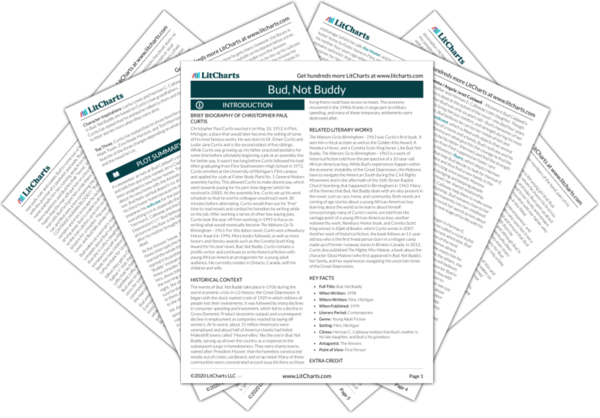Orphaned at an early age, Bud has to navigate the world of racial prejudice and inequality that he’s coming of age in during the Great Depression of the 1930s. Despite Bud’s age, he shows a keen awareness of race and the way it functions in society, such as when he asks Deza Malone why some of the white people in Hooverville were “off alone.” Deza answers that it’s because they insist that because they’re white, they “ain’t in need of a handout.” This exchange, though brief, reveals that Curtis is interested in keeping race a present shadow in the novel. It is his way of subtly making the reader meditate on the external dangers that Bud faces that he, as a young child, may not fully be aware of. References to race juxtapose with Bud’s internal preoccupations and connect the story to America’s history with race and racism. For example, the dangers connected to race are present when Lefty Lewis criticizes Bud for traveling late at night by himself, as well as when Steady Eddie tells Bud that Dirty Deed, the only white man in Herman E. Calloway’s band, has to have Herman’s Log Cabin club in his name for “practical reasons.” These instances are Curtis’s way of revealing that Bud’s coming of age narrative must be accompanied by a strong understanding of the way race works in America. In other words, he suggests that to come of age as a black boy in America, Bud must understand the nuances and dangers of race.
When Lefty Lewis finds Bud on the side of the road in the middle of the night in the Michigan town of Owosso, he is both surprised and relieved to have found Bud because of the racial threat that hides in the dark. He tries to impart on Bud just how “lucky” it is for Bud that he, “came through here,” because “some of these Owosso folks used to have a sign hanging alone here that said […] ‘To Our Negro Friends Who Are Passing Through, Kindly Don’t Let The Sun Set On Your Rear End In Owosso.’” Lefty Lewis emphasizes the dangers of the situation by keeping a hand on Bud, anxious that the boy will flee, to show him that in this scenario, the racial danger trumps whatever fears and wariness Bud has for him as a stranger. Bud notices this and notes that “[Lefty] must not have trusted [him] ‘cause he kept holt of my arm.” This tense moment with Lefty teaches Bud to be vigilant of his surroundings as a young black boy in America. Lefty’s blunt admission is a warning to Bud that surviving and maturing in the society they live in requires stealth and awareness of people who may want to hurt him because of his blackness.
Bud gets another lesson on race when Steady Eddie and Dirty Deed let him in on the secret of the Log Cabin’s ownership and how Herman E. Calloway must navigate unfair racist laws to make a living for himself. Like Lefty, Steady Eddie and Dirty Deed explain things bluntly so Bud can begin to understand and internalize the nuances of race in society and how it impacts who can own property. Steady Eddie tells Bud that “Mr. C. always got a white fella in the band, for practical reasons,” while Dirty Deed further explains that because “it’s against the law for a Negro to own any property out where the Log Cabin is […] Mr. C. put it in [Dirty Deed’s] name.” This moment presents Bud with an opportunity to meditate on how racism functions with the complicity of laws. It is an important conversation that Bud must have in order to fully mature and understand societal barriers he will face as he grows up, but it also shows Bud that, despite beginning to learn and understand the way race works in the country, he doesn’t have to settle for being a second-class citizen—just like Herman E. Calloway.
Race and Racism ThemeTracker

Race and Racism Quotes in Bud, Not Buddy
I opened my eyes to start looking for Miss Hill. She wasn’t at the lending desk, so I left my suitcase with the white lady there. I knew it would be safe.

Unlock explanations and citation info for this and every other Bud, Not Buddy quote.
Plus so much more...
Get LitCharts A+They were all the colors you could think of, black, white and brown, but the fire made everyone look like they were different shades of orange. There were dark orange folks sitting next to medium orange folks sitting next to light orange folks.











